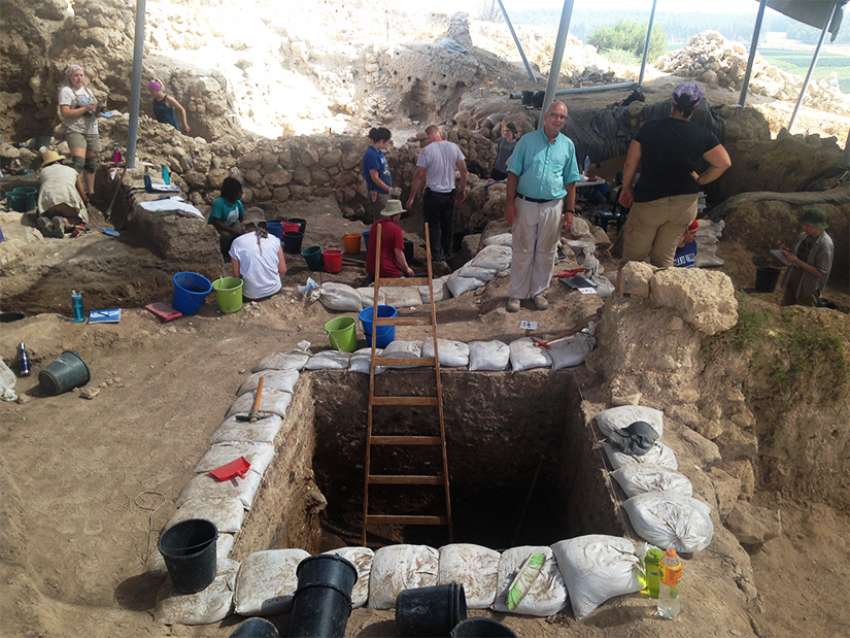The Biblical Archaeology Laboratory at St. Paul’s College, part of the University of Manitoba, is a partner with Bar-Ilan University in Tel Aviv in the excavation of the ancient city of Gath, the birthplace of the menacing giant from the David and Goliath story.
Photo courtesy of Tell es-Safi/Gath Project
St. Paul’s has a tall order in Goliath ancient dig project
By Meggie Hoegler, The Catholic Register
For nine years, students from St. Paul’s College have been helping to uncover the life of Goliath, one piece of ancient pottery at a time.
The Biblical Archaeology Laboratory at St. Paul’s College, part of the University of Manitoba, is a partner with Bar-Ilan University in Tel Aviv in the excavation of the ancient city of Gath, the birthplace of the menacing giant from the David and Goliath story.
St. Paul’s work at Tell es-Safi, Gath’s modern name, has been going on since 2008. Dr. Haskel Greenfield, a professor of anthropology and archaeology at St. Paul’s College and co-director of Early Bronze excavations at Tell es-Safi, has been on the project since its inception.
“We are interested in uncovering everyday objects that will give us an idea of what these people’s everyday lives looked like,” said Greenfield, who has brought over 100 students to Israel to help with excavation and research. His team’s focus is on objects from the Early Bronze Age.
The school’s participation in the project was inspired by the Christianity’s roots and history in Israel.
“St. Paul’s is founded in the Jesuit tradition,” said Christopher Adams, Director of St. Paul’s College. “We believe in serving others through being an active presence in the community. One of the ways in which we do that is through the archaeological excavation at Tell es-Safi. There is so much history between Christianity and Israel so it is important that we foster that relationship.”
St. Paul’s was founded by the Oblate Fathers in 1926 as the first English-speaking Catholic high school for boys in Manitoba. In 1936, it joined forces with St. Mary’s College for Women and later with the University of Manitoba. It is the largest Catholic post-secondary institution in the province.
Tiffany Okaluk, a graduate student and member of St. Paul’s College who has participated in the excavation for two years, said they found several pieces of pottery with names inscribed on the surface that are similar to Goliath. “We don’t know if they belonged to the Goliath from the story or if it’s someone else entirely,” she said. “It is possible that Goliath was as common a name as John for the Philistines.”
The excavation site is 10 km from the valley that David and Goliath’s battle supposedly took place. Universities in Israel, the United States and Australia have also helped to excavate Tell es-Safi. In 2014, archaeologists from Bar-Ilan University uncovered the Gates of Gath, which is referenced in the Book of Samuel when David flees from Saul.
“It’s fascinating to know that this could be the birthplace of Goliath, but it’s also a place where many other biblical stories took place. There is so much history here,” said Okaluk. “Being able to link biblical stories with archaeology is incredible.”
Greenfield says he cannot confirm that this is the site of Goliath’s birth without tangible archaeological evidence, which is hard to come by.
“We cannot judge the past by today’s standard,” said Sarah Richardson, a PhD student at the University of Manitoba who also participated the excavation this past summer. “We can’t fact-check ancient history. But it is the common consensus within the archaeological community that this is Goliath’s birthplace. There are numerous other sites of ancient cities along the valley of Tell es-Safi that are mentioned in the story of Goliath so logically speaking it makes sense.”
Participation in the excavation is open to undergraduate, graduate and PhD students at St. Paul’s College. The credits earned count towards the students’ grade point average. The students participate in the dig in the summer, uncovering artifacts and conducting field work, then spend the fall researching the objects back in the archaeology lab in Winnipeg.
(Note: This story has been updated and some dates clarified. St. Paul’s students have been participating in the excavation since 2008.)
Please support The Catholic Register
Unlike many media companies, The Catholic Register has never charged readers for access to the news and information on our website. We want to keep our award-winning journalism as widely available as possible. But we need your help.
For more than 125 years, The Register has been a trusted source of faith-based journalism. By making even a small donation you help ensure our future as an important voice in the Catholic Church. If you support the mission of Catholic journalism, please donate today. Thank you.
DONATE

